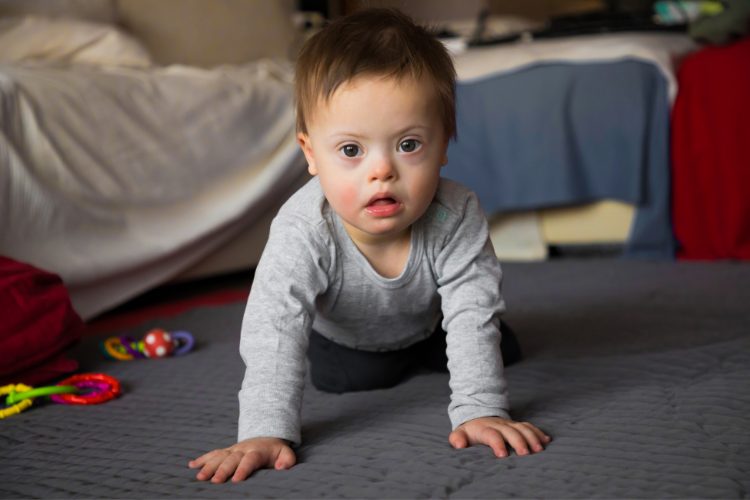Guest Post by Katy Fleming, MA, LPC, BSN, RN
As the most common chromosomal disorder, Down Syndrome affects approximately 1 in every 700 babies. Increasing your understanding of Down Syndrome and how to best support a child with the diagnosis promotes early intervention and effective care.
This genetic condition has 3 types consisting of Trisomy 21, Translocation, and Mosaic. We’ll focus on Trisomy 21 as it accounts for 95% of all cases.

Everything Parents Need to Know About a Trisomy 21 (Down Syndrome) Diagnosis
Let’s learn more about the screening and diagnosis process of Trisomy 21, better known as Down Syndrome.
What is Trisomy 21?
When a person is born with an extra chromosome, it’s known as a Trisomy. Human beings typically have 46 chromosomes of 23 pairs. In Trisomy 21, the baby is born with two pairs of chromosome 21 rather than the typical three. This additional chromosome causes the body and brain to develop differently than someone without the condition.
In the 1960s, the life expectancy for a person with Down Syndrome was approximately 10 years old. As medical treatment, resources, and awareness increased, so did the average lifespan for those with this condition. Today, the average life span is 60 years old.
Trisomy 21 provides a higher risk for different health conditions, developmental delays, and intellectual disabilities. Many people with Down Syndrome have distinct facial features such as a shorter neck, almond-shaped eyes, a smaller head, a flattened face, poor muscle tone, protruding tongue, and shorter height.

It’s important to remember that each individual is different with unique characteristics. Not every baby born with Down Syndrome will have all the features or complications mentioned.
Risk Factors
Although medical professionals do not know exactly why some people are born with an extra chromosome, there are some known risk factors for Down Syndrome.
Age is the most well-known risk factor. Women over the age of 35 are more likely to have a baby born with Down Syndrome. Since younger women more commonly have babies, 80% of babies with Down Syndrome are born to women younger than 35.
Screening and Diagnostic Tests
When pregnant, screening and diagnostic tests assist with the diagnosis of Down Syndrome. Screening tests determine if there’s a higher probability that the baby has Down Syndrome, however, it cannot confirm a diagnosis.
Screening consists of blood tests and an ultrasound. If you receive a positive screening test, then more diagnostic testing will typically occur.
Diagnostic testing consists of chorionic villus sampling, percutaneous umbilical blood sampling (PUBS), and amniocentesis.
Chorionic villus sampling examines cells from the placenta to assess chromosome abnormalities. In amniocentesis, a needle is inserted into the mother’s uterus to obtain the sample, which then examines the chromosomes. Finally, in PUBS, the fetus’ blood is taken directly from the umbilical cord for analysis.

Health Concerns
People with Down Syndrome often have intellectual and developmental disabilities. Developmental disorders may include learning disabilities and Autism.
A person with Trisomy 21 may experience health problems, as well. Some common health concerns are ear infections, eye diseases, congenital heart disease, hearing loss, epilepsy, endocrinologic disorders, and obstructive sleep apnea.
Again, each person with Down Syndrome will experience different medical problems and developments. It’s important to build awareness and understanding while recognizing that your child may not experience these conditions.
Additional Resources
It’s important to build a team of experts to support your child with Down Syndrome. This may include a cardiologist, ophthalmologist, gastroenterologist, speech pathologist, and physical therapist to name a few.
Additional support is provided by early intervention programs to promote language, motor, and social skills. Once your child reaches school age, an Individualized Education Plan (IEP) provides support for your child to thrive in their education.
As a parent, it’s important to seek support for yourself, as well. You can connect with other parents of children with Down Syndrome through support groups. The National Down Syndrome Society provides a list of local support across the nation.
There are countless resources for you and your child with Down Syndrome. When given support and necessary medical care, people with Down Syndrome can thrive in fulfilling and happy lives.
If you are looking for addition resources on Down Syndrome, try these:
- 3 Important Facts About Down Syndrome
- Toys Children With Down Syndrome Will Love to Be Gifted
- How the NozeBot Can Help Those With Down Syndrome
- Helping Jed Breathe Easy
As a licensed counselor and registered nurse, Katy approaches freelance writing with years of experience and a unique perspective. Alongside her partner, Katy loves to travel the world and embrace other cultures from volcanoes in Iceland to villages in India.
The Nozebot is a battery-powered suction device designed to clear nasal congestion in babies and children.



